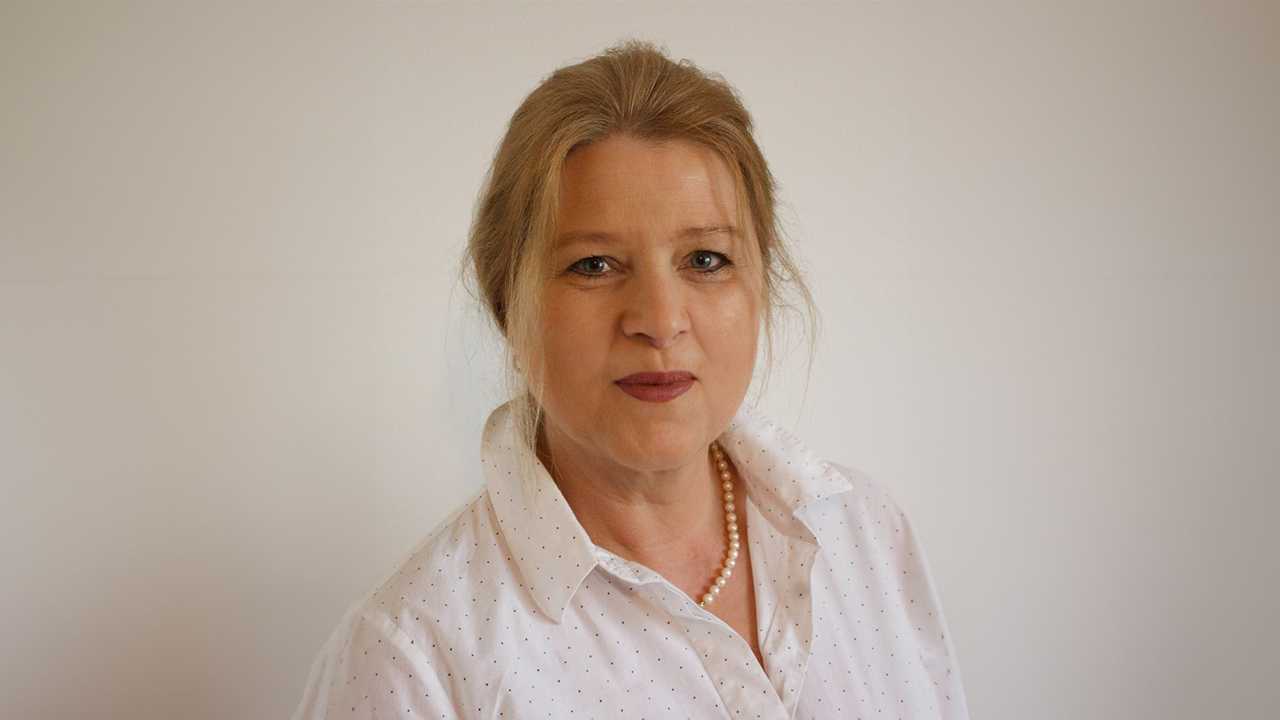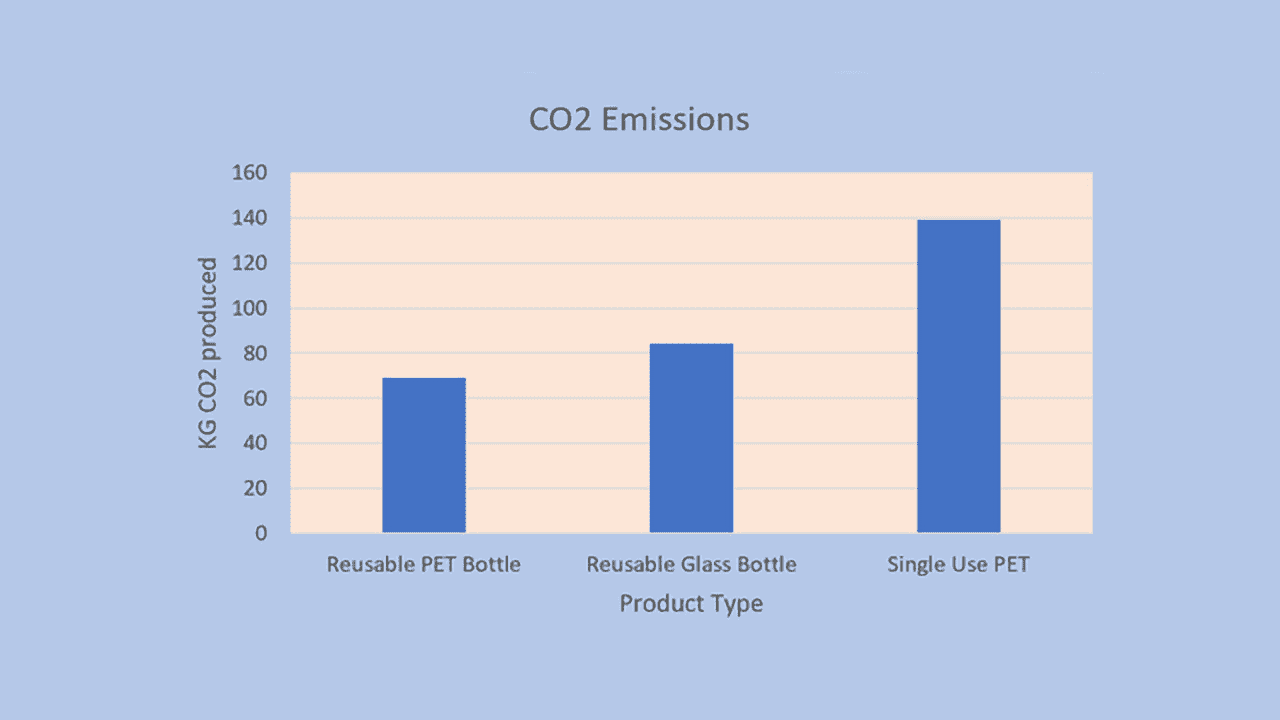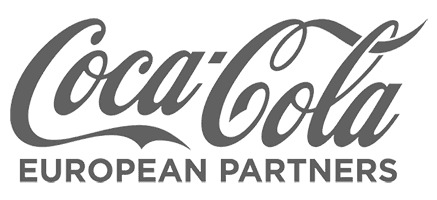Article04-04-2022
Why 2022 is the time to transition to Refillable PET Bottle packaging
In a recent news segment on German news channel ‘Das ERSTE’, newscasters discussed the Deposit Return Scheme (DRS) running in the country. The DRS works on a simple premise, that on PET or Glass Bottles there is a small deposit that can be reclaimed when the packaging is returned to the store. There are 3 categories in the system, Single Use PET plastic bottles, Reusable Glass Bottles and Reusable PET bottles. One graphic show laid out the respective carbon footprint of each type (fig.1), showing Reusable PET Bottles as the most carbon friendly packaging solution. With Germany leading the way in refillable packaging, we speak with Anna Schoon, Petainer’s Key Account Manager for Refillable PET Bottles to explore why 2022 is the year to begin pivoting to Refillable PET Bottle packaging.

Plastic waste is an issue seen less in countries that operate Deposit Return Schemes with refillable packaging, can you suggest why this might be?
A Deposit Return Scheme encourages the return of bottles into the system, as throwing a bottle away is to throw away the deposit paid on it. Single Use PET Bottles have a higher deposit compared to Refillable PET Bottles, a recognition of the higher potential environmental impact of single use plastic bottles. This makes it easier for customers to choose the more environmentally friendly option, Refillable PET Bottles. With customers able to return bottles to participating supermarkets, it’s convenient and quick and it shows – Germany’s recycling rates are as high as ~94%. The clear benefit is less plastic leaking into the environment, which costs to be cleaned up. In Spain, which does not have a DRS, 744 million euros is allocated to clean abandoned packaging waste every year.

In Germany, some producers can access a pool bottle – is this an easy way to get started as a producer?
In Germany, producers can access a ‘pool bottle’, which is a bottle of the same shape used by many brands. Genossenschaft Deutscher Brunnen (GDB) for example offer a pool bottle to mineral water bottlers across Germany, servicing over 180 mineral water springs. The now famous ‘Pearl’ bottle used by GDB is manufactured by Petainer in the Czech Republic. When a GDB pool bottle is collected via the DRS, they all get taken to a processing plant and can be accessed by the producer once washed and checked. What this allows for is for producers to always have access to a bottle to fill, even if the bottle is returned in a different region. This is because bottlers are supplied from a regional warehouse, not from their own supply that they would have to recuperate. As pool bottles are necessary to maintain the loop, they are more likely to be processed for their maximum lifespan.
With recycled PET prices soaring, can switching to refillable bottles help?
The supply of rPET (recycled PET) is under strain currently. European directives are pushing a shift to 25% recycled content for one-way bottles by 2025 and 30% by 2030. At the same time, differing consumer habits during the Covid pandemic have resulted in less plastic waste moving through the recycling system, reducing the supply of rPET. A well-run DRS scheme reduces risk to material supply when high quality PET packaging is collected and kept together to reduce contamination of mixed materials.
Incorporating recycled material into a single use plastic bottle will reduce its carbon footprint, with the average percentage sitting at around 25% currently. A Refillable PET Bottle with no recycled material, however, has a lower carbon footprint than a one-way bottle with rPET content. Without the need to incorporate rPET to meet sustainability goals, Refillable PET Bottles offer a perfect solution. Further, a Refillable PET Bottle will use 90% less plastic over its lifespan, as every fill removes a bottle of the same volume from being made. At end of life, Refillable PET Bottles are bottle-to-bottle recyclable and are converted into new products without losing any of its properties. It should be noted, that up to 30% rPET can be added to refillable bottles, adding further to their sustainability, and for those with ambitious targets is an option that should be considered.
Shoppers return their reusable packaging in a reverse vending machine or hand it over at the store.
What in 2022 could precipitate a big shift to refillable bottles?
Germany’s newly elected coalition government is now in place, and commenters are expecting it to lead with a green focus, which could bring the shift from single use packaging to refillable. The first expected step is to put in place stringent measures to hit the existing 70% target for refillable packaging by the end of 2022, which had fallen to 43% as of 2019. The biggest roadblock to date has been cost cutting amongst supermarkets and producers which has driven more one-way bottle sales. With political will exerted by the new coalition government, producers can expect this market to open to refillable packaging and reap the benefits. Outside of Germany, the EU is being pushed to bring in a 50% refillable target by 2030, which could save up to 3.7 million tonnes of CO2 from being emitted. This is not just a European change, many brands in Mexico are extending their range of products available in refillable PET bottles. There is therefore, clear appetite globally for more refillable packaging.
How does moving to refillable PET bottles impact the environment?
For beverage producers, using 1L Refillable PET Bottles with 30% recycled content can lead to a carbon footprint reduction of 28% (vs 0% rPET), and against refillable glass has an 81% benefit in carbon reduction over its lifespan. Refillable PET bottles that are retired from the supply chain are simply removed from the bottle pool to be recycled and used in the production of new bottles. The recycled content coupled with the renewable energy powering Petainer’s sites, is helping brand owners meet their sustainability targets, and work towards becoming carbon neutral.
At a time where customers perceive the end-of-life solutions of a product just as important as the carbon footprint, the Refillable PET Bottle with recycled PET is the ultimate sustainable solution. This combination of reuse, recycled content, and responsible end-of-life, makes Refillable PET Bottles perfectly suited for the circular economy.
Petainer has started offering closed loop recycling, this seems like it will make a big difference to customers?
Petainer offers a real closed loop for recycling. When a bottle is retired from the refillable scheme, we are now able to recycle these into new bottles. At our Czech factory, we take in recycled PET sourced from the DRS scheme and process this material in to ESFA approved recycled PET flakes. A true closed loop guarantees high quality feedstock as we can avoid mixed plastics, labels and other foreign material entering the stream. Petainer’s system is unique in offering a true closed loop solution with lower CO2 emissions compared to other forms of processing. Within the closed loop model, producers are maximizing the value of their plastic waste. Instead of needing to buy rPET at the market rate, a producers own supply can be used, reducing the overall cost of new bottles, and guaranteeing the PET gets recycled.
Refillable bottles are bottle to bottle recyclable. Petainer can offer Petainer IR Flake, our own rPET material.
Conclusion
It is Petainer’s view that Refillable PET Bottles are an essential tool in reducing plastic waste in the environment, reduce carbon emissions and supporting a healthier usage of plastic. New DRS schemes that do not include refillable PET packaging are missing out on the benefits; they shouldn’t be used just to solve the immediate problem of reducing plastic waste spilling into the environment, they are the step change in altering consumer behaviour when it comes to packaging.





